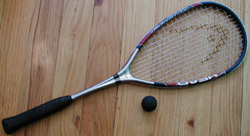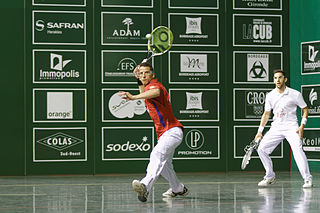Related Research Articles

Tennis is a racket sport that is played either individually against a single opponent (singles) or between two teams of two players each (doubles). Each player uses a tennis racket that is strung with cord to strike a hollow rubber ball covered with felt over or around a net and into the opponent's court. The object of the game is to manoeuvre the ball in such a way that the opponent is not able to play a valid return. The player who is unable to return the ball validly will not gain a point, while the opposite player will.

Table tennis is a racket sport derived from tennis but distinguished by its playing surface being atop a stationary table, rather than the court on which players stand. Either individually or in teams of two, players take alternating turns returning a light, hollow ball over the table's net onto the opposing half of the court using small rackets until they fail to do so, which results in a point for the opponent. Play is fast, requiring quick reaction and constant attention, and is characterized by an emphasis on spin relative to other ball sports, which can heavily affect the ball's trajectory.

A racket, or racquet, is a sports implement used for striking a ball or shuttlecock in games such as squash, tennis, racquetball, badminton and padel. In the strictest sense a racket consists of a handled frame with an open hoop across which a network of strings is stretched tightly. Some rackets may have a solid or perforated hitting surface instead of a network of strings. Such rackets may be called a paddle or bat. Collectively, these games are known as racket sports.

Real tennis – one of several games sometimes called "the sport of kings" – is the original racquet sport from which the modern game of tennis is derived. It is also known as court tennis in the United States, formerly royal tennis in England and Australia, and courte-paume in France. Many French real tennis courts are at jeu de paume clubs.

Rackets or racquets is an indoor racket sport played in the United Kingdom, United States, and Canada. The sport is infrequently called "hard rackets", to distinguish it from the related sport of squash.

A tennis ball is a ball designed for the sport of tennis. Tennis balls are fluorescent yellow-green in organised competitions, but in recreational play can be virtually any color. Tennis balls are covered in a fibrous felt, which modifies their aerodynamic properties, and each has a white curvilinear oval covering it.
Howard Head was an American aeronautical engineer who is credited with the invention of the first commercially successful aluminum laminate skis and the oversized tennis racket. Head founded the ski making firm Head in 1950. Later he became chairman of Prince Manufacturing Inc. The U.S. patents for the laminate skis and oversized tennis racket are in the name of Howard Head. He graduated from Harvard College in 1936.

Prince Global Sports, LLC is an American sporting goods manufacturing company based in Atlanta, Georgia. Founded in 1970, Prince's range of products includes rackets, footwear, apparel, tennis balls, pickleball paddles, stringing machines, hats and bags.

Frontenis is a sport that is played in a 30 meter pelota court using racquets and rubber balls. It can be played in pairs or singles, but only pairs frontenis is played in international competitions. This sport was developed in Mexico around 1900, and is accredited as a Basque pelota speciality.
In tennis, the strings are the part of a tennis racquet which make contact with the ball. The strings form a woven network inside the head of the racquet. Strings have been made with a variety of materials and possess varying properties that have been measured, such as dynamic stiffness, tension retention, thickness (gauge), string texture, and rebound efficiency.

The Wilson Pro Staff Original, first introduced in 1984 is most known for being the model of racquet used by Pete Sampras. For this reason, it is known as a “Sampo”.
Head Sport GmbH is an American-Austrian manufacturing company headquartered in Kennelbach. It owns the American tennis racket brand Head. Head GmbH is a group that includes several previously independent companies, including the original "Head Ski Company" ; Tyrolia, an Austrian ski-equipment manufacturer; and Mares, an Italian manufacturer of diving equipment.
The shaft of a golf club is the long, tapered tube which connects the golfer's hands to the club head. While hundreds of different designs exist, the primary purpose of the golf shaft remains the same: to provide the player with a way to generate centrifugal force in order to effectively strike the ball. When properly gripped the player can hit the ball further and more accurately, whilst applying less force.
Dunlop Sport is a British sports equipment manufacturing company established in 1910 that focuses on racquet sports, more specifically tennis, squash, padel and badminton. Products by Dunlop Sport include rackets, strings, balls, shuttlecocks, and bags. Sportswear and clothing line includes t-shirts, shorts, skirts, jackets, pants, socks, caps, sneakers, and wristbands.

A wood is a type of club used in the sport of golf. Woods have longer shafts and larger, rounder heads than other club types, and are used to hit the ball longer distances than other types.

Four wall paddleball, or paddleball, is a popular court sport in the Upper Midwest of the United States, on the West Coast of the U.S. and in the Memphis, Tennessee area. It is played with a paddle and small rubber ball on a standard handball or racquetball court, with similar rules to those sports.

Donnay Sports is a sports equipment brand currently owned by Frasers Group. The company was founded in 1910 by Emile Donnay and was based in Couvin, Belgium. Donnay manufactured wooden tennis rackets from 1934, and by the 1970s was the largest manufacturer of tennis rackets in the world. However, the company failed to adapt to the new market for graphite rackets, and entered administration in 1988. After a succession of owners, the brand was eventually sold to Sports Direct International, who continue to license the use of the brand worldwide.

The Bentley Fortissimo tennis racquet of 1972 was the first oversize tennis racquet to be produced and demonstrated publicly. Prior to its introduction, all tennis racquets were much smaller in terms of the stringbed size, measured in square inches. Today, that size, known as standard, is not used by any professional player for professional match play.

ProKennex is a Taiwanese manufacturer of racquet sports equipment for tennis, squash, badminton, racquetball, and pickleball. The company enjoyed wide global distribution in the 1980s, when manufacturing in Taiwan was booming due to domestic economic conditions. Parent company Kunnan Enterprise Ltd. has faced financial difficulties since the mid 1990s, leading to a contraction of the ProKennex name globally. Today, the company focuses on a niche set of consumers interested in technology advancements in racquet sports. The company focuses on this aspect of its products by promoting itself as a "science and design company", rather than a standard racket manufacturer.
References
- ↑ Staff (2022-11-17). "What If Graphite Was Never Sanctioned". The Resource Nexus. Retrieved 2023-05-02.
- 1 2 "The quest for the tennis sweet spot". 12 September 2005.
- ↑ Bud Collins' Modern Encyclopedia of Tennis
- ↑ Khan, Sajid (2021-06-10). "racquets are made up of graphite". ElasticReviews.com. Retrieved 2021-07-16.
{{cite web}}: CS1 maint: url-status (link) - ↑ .Such controversy resembles the recent disputes about speed skaters' drag-diminishing garments and friction drop of swimwear worn at Olympic Games. Kim, Hann Earl; Johannes M. Pennings (2009). "Innovation and Strategic Renewal in Mature Markets: A Study of the Tennis Racket Industry". Organization Science . 20 (2): 368–383. doi:10.1287/orsc.1080.0420.
- ↑ Tennis: Game of Motion by Eugene Scott